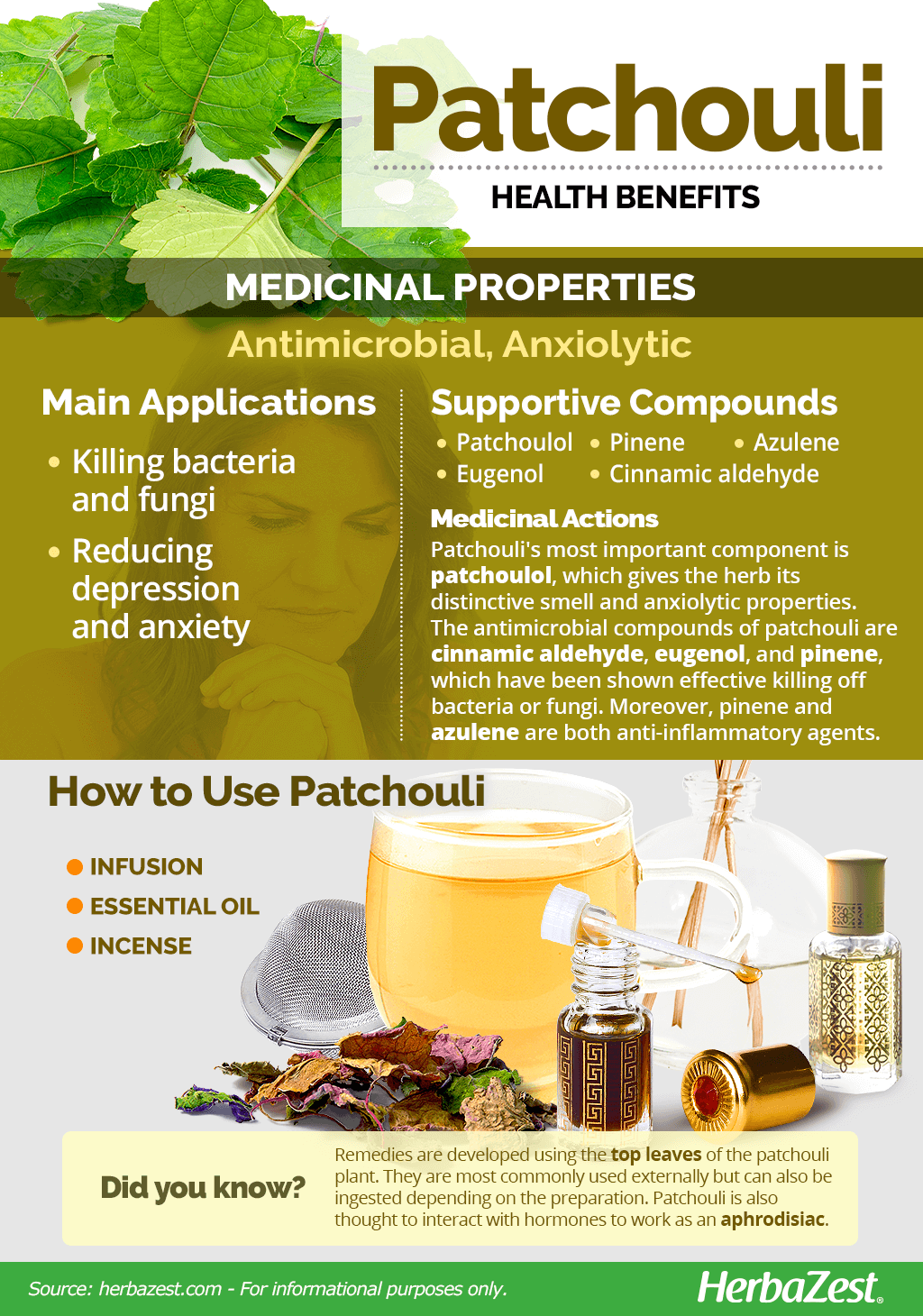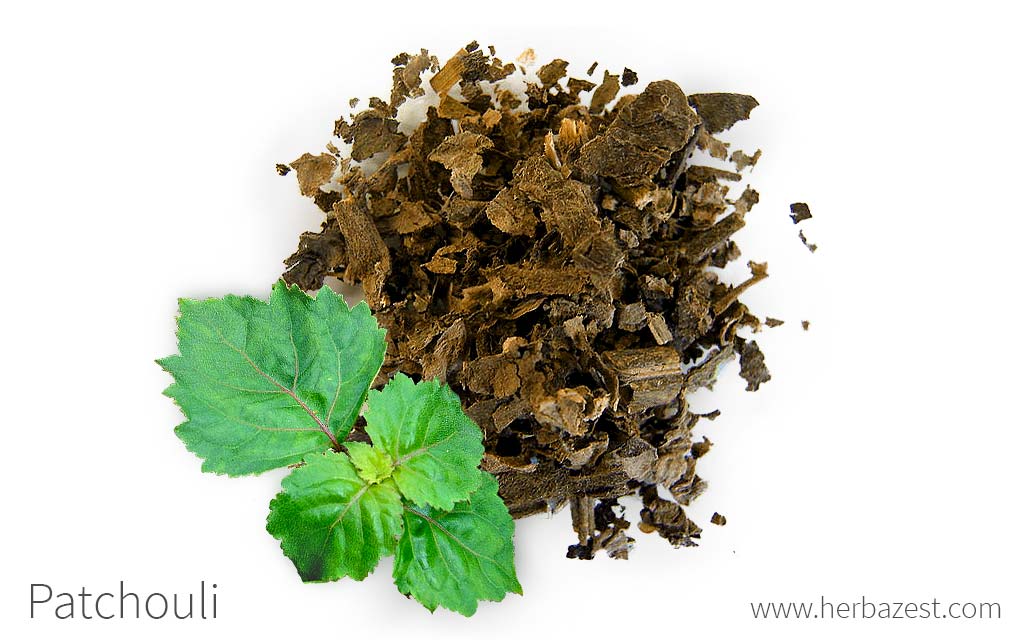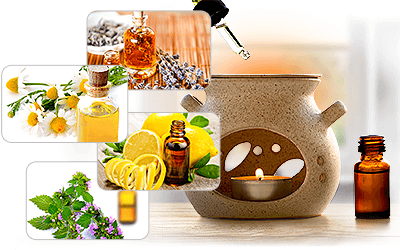Though patchouli may be best known in the West for its association with the psychedelic seventies, its history extends far beyond those years. It was an important component of ancient medical treatments as well as a common ingredient in early perfumes. Today, patchouli oil is still widely sought after for its distinctive scent and its many health benefits.
Patchouli Medicinal Properties
- Medicinal action Antimicrobial, Anxiolytic
- Key constituents Patchoulol, cinnamic aldehyde, eugenol, pinene, azulene
- Ways to use Hot infusions/tisanes, Incense, Essential oil
- Medicinal rating (4) Very useful plant
- Safety ranking Safe
Health Benefits of Patchouli
While patchouli is known for its intense, hearty aroma, it also possesses an interesting set of medicinal properties. Modern studies have corroborated the most useful patchouli's benefits, including:
Killing bacteria and fungi. Antimicrobial substances found in patchouli can help fight infections.
Reducing depression and anxiety. Patchouli is a known mood enhancer and can help alleviate symptoms of stress.
Other patchouli's benefits, mostly used in folk medicine, are:
Healing skin conditions. Many different skin ailments, such as eczema and overly oily skin, can be improved by using patchouli.
Reducing fever and inflammation. The anti-inflammatory properties of patchouli make it useful for alleviating fevers as well as several types of internal and external inflammation.
Patchouli is also thought to interact with hormones to work as an aphrodisiac, but studies have not offered conclusive scientific evidence.
How It Works
Patchouli's most pungent component is patchoulol, the alcohol that gives the herb its distinctive smell and anxiolytic properties.1 On the other hand, cinnamic aldehyde, eugenol, and pinene are antimicrobial compounds that have been shown effective for killing off bacteria or fungi.2 Pinene and azulene both work as anti-inflammatory agents.3 However, the compounds and processes that allow patchouli to provide some of its other benefits are not yet fully understood.
Herbs with calming, anxiolytic properties are skullcap and St. John's wort, whereas calendula and thyme provide antimicrobial benefits.
Patchouli Side Effects
Patchouli is mostly safe to use topically, although the undiluted oil may cause some redness and skin irritation, as well as photosensitivity. It is recommended to dilute the oil with water before topical use and to keep it away from the eyes. A less common side effect is loss of appetite, so those already struggling with low appetites should refrain from using patchouli.
Patchouli Cautions
There are no known medical interactions with patchouli, so it is safe to use with other drugs. However, pregnant and breastfeeding women are advised to avoid using patchouli, as its effects during those stages have not been thoroughly investigated and could be dangerous. Additionally, it is important to seek the advice of a doctor before ingesting patchouli in any form.
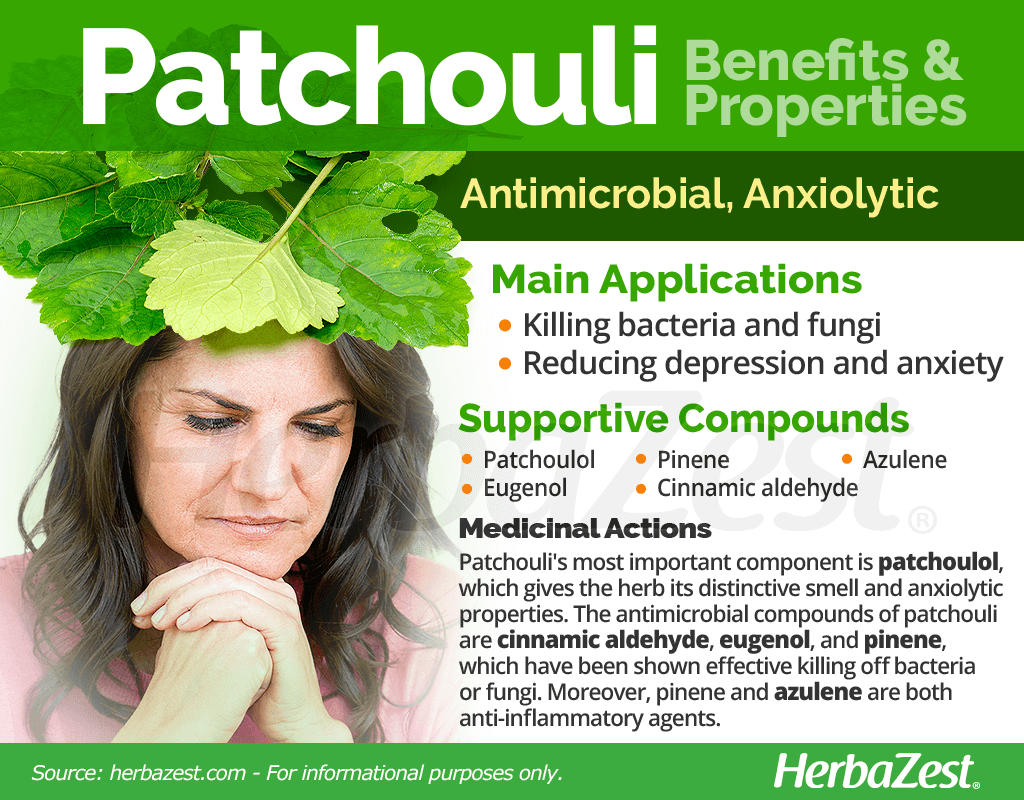
How to Consume Patchouli
- Edible parts Leaves
- Edible uses Flavoring
Patchouli appears in culinary preparations strictly as a flavoring; however, foods seasoned with this herb have no medicinal value. In order to obtain its health benefits, patchouli should be used in medicinal forms.
Patchouli remedies are developed using the top leaves of the plant. They are most commonly used externally but can be ingested depending on the preparation.
Natural Forms
Infusion. Dried patchouli leaves can be brewed into a tea that offers all its health benefits.
Herbal Remedies & Supplements
Essential oil. This is the common remedial form of patchouli. It can be applied topically to eradicate bacterial or fungal infections, soothe skin ailments, or reduce inflammation. It can also be diffused to release a soothing scent that can help improve mood or lower anxiety.
Incense. Another common form of patchouli is incense. Like with the aromatic use of the oil, the aroma of patchouli incense is thought to ameliorate mild depression and anxiety.
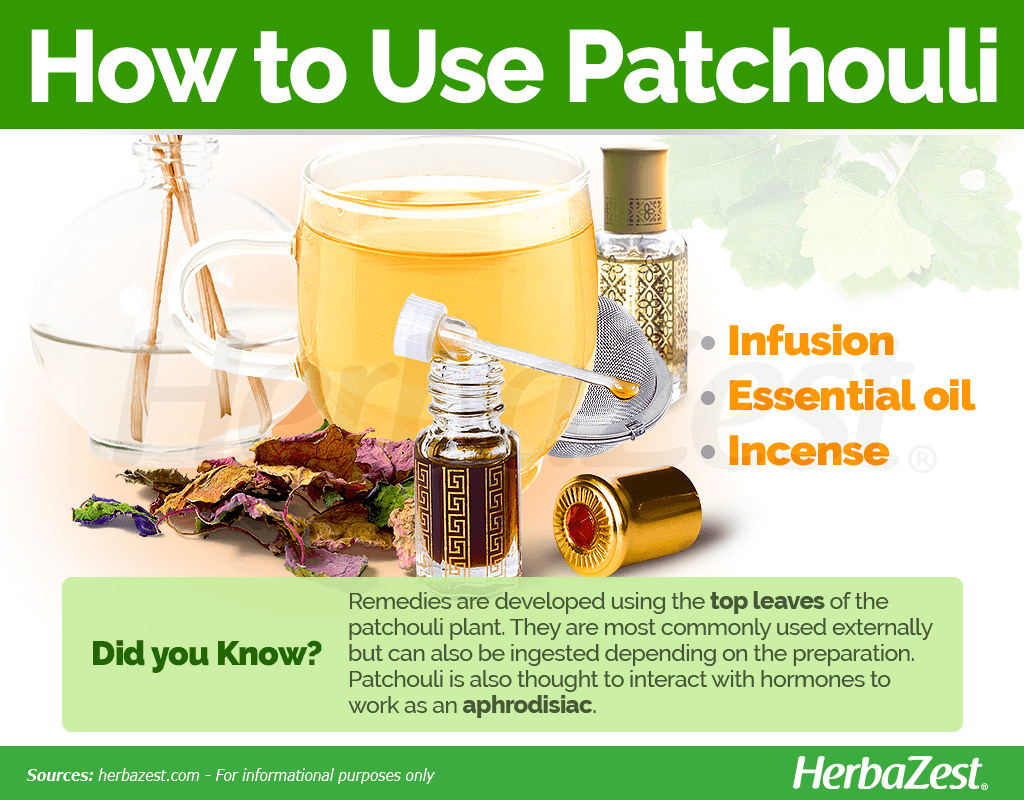
Growing
- Life cycle Perennial
- Harvested parts Leaves
- Light requirements Full sun, Partial shade
- Soil Medium (loam)
- Soil pH 5.6 – 6.0 (Moderately acidic), 6.1 – 6.5 (Slightly acidic)
- Growing habitat Tropical regions, Warm climates
- USDA Plant Hardiness Zones 10a, 10b, 11a, 11b
- Planting time Spring
- Plant spacing average 0.6 m (1.97 ft)
- Growing time 6 months
- Propagation techniques Cuttings
- Potential insect pests Nematodes, Caterpillars, Leafminers
- Potential diseases Leaf spot
Because of the long process needed to turn patchouli leaves into oil or incense, this herb is hardly found in personal gardens. However, some enjoy its appearance and scent and add it to their gardens as a decorative plant. Patchouli, a perennial herb, can be successfully cultivated at home with a little care.
Growing Guidelines
Patchouli should be planted in rich, moist, and slightly acidic loamy soil with a pH level ranging from 5.5 - 6.2.
Humid conditions are the best for patchouli's development, and the plant should be watered daily to ensure premium growth.
Although patchouli plants can grow even in the shade, their ideal lighting situation is full to partial sunlight.
Patchouli thrives mainly in hardiness zones 10 and 11.
Cuttings or, less commonly, seeds should be planted in the spring, after the temperature is likely to stay warm enough for the herb to survive - above 65°F (18°C). In cooler regions, it may be advisable to plant the herb outdoors in a pot so it can be brought indoors in the autumn and winter months.
Patchouli cuttings should be spaced two feet (1 m) apart when planted together.
The top leaves of the plant, which are used to create the oil, tea, and incense, can be harvested six months after planting and can then continue to be harvested two to three times per year.
Patchouli should be replanted every three to four years because frequent harvesting of the leaves weakens the plant.
The herb is susceptible to a few pests and diseases. Root knot nematode is one of the most common ailments of the patchouli plant.
Additional Information
- Other uses Dye, Perfume, Repellent
Plant Biology
Patchouli is a shrubby perennial plant that can grow up to three feet (1 m) tall in ideal conditions. Patchouli leaves, the part of the plant that is used to produce the remedies, are egg-shaped and generally grow to be four inches (10 cm) long. Its stems are squared, and the flowers tend to be white, although they can range from white to a light purple.
Because patchouli has been popular for so many years, it has collected several different colloquial names. It may also be referred to as East Indian herb, Indian mint, paccilai, and pucha-pat or putcha-pat.
Classification
Patchouli, or Pogostemon cablin, is a member of the Lamiaceae family. This family is often called the mint family, and it contains several other aromatic herbs, such as lemon balm and peppermint.
Related Species
The genus Pogostemon includes over 90 species of plants native to the warm parts of Asia, Africa, and Australia, but three species are most closely related to P. cablin: P. heyneanus, P. paniculatus, and P. plectranthoides. Each of these three plants can be used to distill oil, but all three are considered inferior because the quality and scent of the oil is less desirable than P. cablin. P. plectranthoides in particular produces an oil with an unpleasant smell. P. heyneanus, also called Java patchouli, is generally grown for its leaves, which are not turned into oil but sold in dried form.
Historical Information
Patchouli has been a popular herb for thousands of years. In ancient times, it was used for its many medicinal properties. In fact, it is one of the only herbs to be mentioned in all three of the ancient medical systems: Chinese, Ayurvedic, and Greek.
In the 19th century, patchouli was imported to the United Kingdom along with Asian scarves and cloth, and it gained popularity among the British for its association with the mysterious East. More recently, patchouli was known in the seventies as a way to mask the scent of cannabis. Many Westerners still associate the scent of patchouli with a hippie lifestyle.
Economic Data
Patchouli is a popular and economically-important plant, with a worldwide demand of 1,500 - 2,000 tons per year. The demand is mainly for the oil distilled from the plant's leaves. This oil has no synthetic equivalent, which keeps the plant consistently in high demand. The top distributors of patchouli are Indonesia, the Philippines, Malaysia, and Singapore, with Indonesia distributing close to 90% of the world's demand.
Popular Beliefs
In ancient times, patchouli was used for more than just healing and perfume. Because of patchouli's potential use as an aphrodisiac, it was thought that using patchouli oil as a perfume could attract the opposite sex.
Other Uses
Perfumery. Its strong, distinctive scent has been used in perfumes for thousands of years, and it remains popular, both alone and as a base for other scents. It is also a common component of candles and massage oils.
Dye. Historically, patchouli was used as an ingredient in Indian inks; the addition of patchouli kept the color fixed and its alcohol content helped the ink to dry more rapidly once used.
Repellent. Additionally, the oil from patchouli can be an effective insect repellent thanks to its component benzaldehyde. In the past, patchouli was added to clothing in Asia to prevent moths from destroying the cloth.
Apiculture. It can also be useful for beekeeping; using some patchouli oil when harvesting honey can protect the beekeeper from being stung by their bees.
Patchouli is a fragrant addition to any herb garden, and it can be found commercially all over the world. Its many medicinal uses - notably, its ability to ease anxiety and heal skin conditions - make it a highly popular and beneficial plant.
Sources
- American College of Healthcare Sciences, Essential Oil of Patchouli
- Aromatic Plants, pp. 123 - 125
- Aromatica: A Clinical Guide to Essential Oil Therapeutics, pp. 279 - 284
- China Medicine, Pharmacological activities and mechanisms of action of Pogostemon cablin Benth: a review, 2021
- Heritage Garden, Patchouli (Pogostemon heryneanus)
- Leafy Medicinal Herbs: Botany, Chemistry, Postharvest Technology and Uses, pp. 200 - 206
- Let's Get Natural With Herbs, p. 332
- Medical Aromatherapy for Healthcare Professionals, pp. 43 - 44
- Molecules, A Comprehensive Review on the Phytochemical Constituents and Pharmacological Activities of Pogostemon cablin Benth.: An Aromatic Medicinal Plant of Industrial Importance, 2015
- The Alberta Beekeeping Manual, p. 91
- The Natural Health Dictionary
- Tropical Planting and Gardening with Special Reference to Ceylon, pp. 382 - 383
- University of Georgia, Cooperative Extension, Herbs in Southern Gardens
Footnotes:
- Pharmaceuticals. (2022). Antidepressant-like Activity of Patchouli Oil var. Tapak Tuan (Pogostemon cablin Benth) via Elevated Dopamine Level: A Study Using Rat Model. Retrieved January 23, 2023, from: https://www.ncbi.nlm.nih.gov/pmc/articles/PMC9145128/
- Iranian Journal of Pharmaceutical Research. (2013). Evaluation of the Antibacterial Activity of Patchouli Oil. Retrieved January 23, 2023, from: https://www.ncbi.nlm.nih.gov/pmc/articles/PMC3813264/
- Photodiagnosis and Photodynamic Therapy. (2022). Photodynamic anti-inflammatory activity of azulene derivatives on mammalian macrophages and their intracellular mechanism of action. Retrieved January 23, 2023, from: https://www.sciencedirect.com/science/article/abs/pii/S1572100022002496
